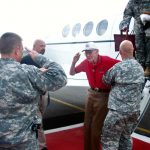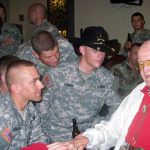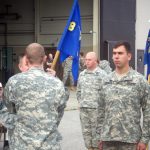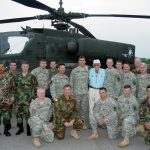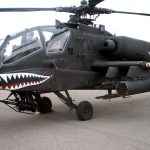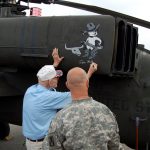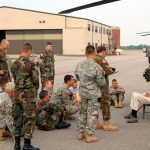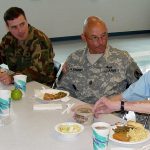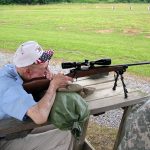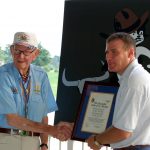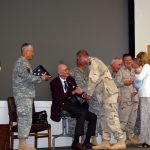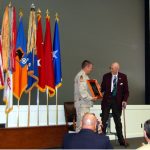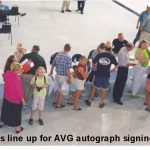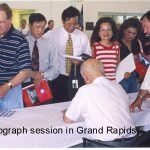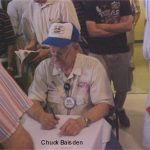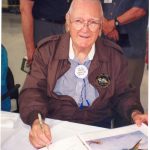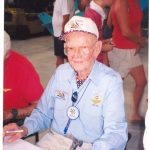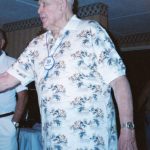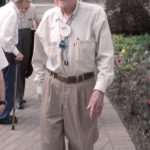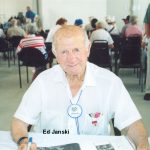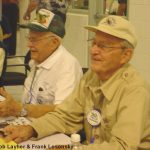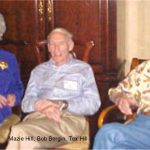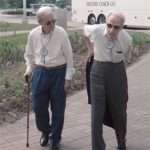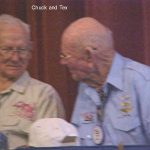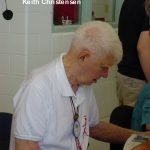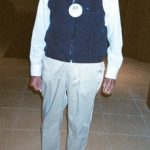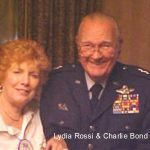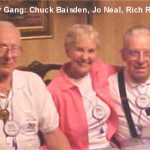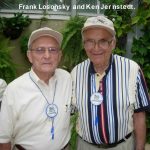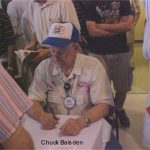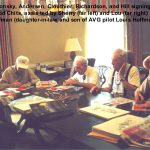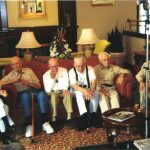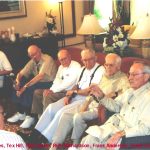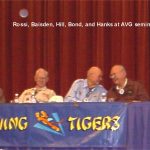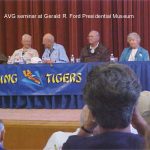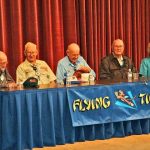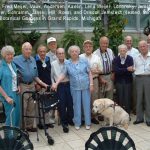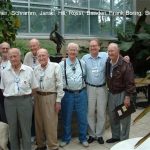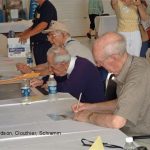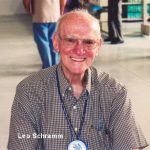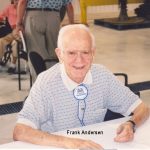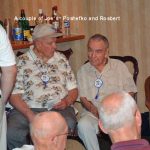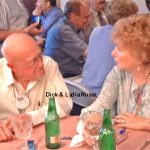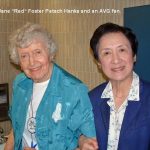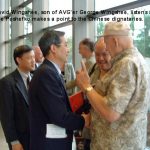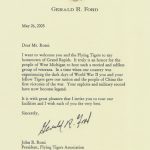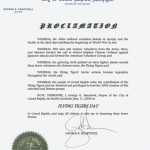
AVG Events
Sep. 21-24, 2017 – 76th Anniversary AVG Reunion in Florida
An exciting gathering is planned for our Tigers and their families—stay tuned for more details! We will let you know of any public events.
Sep. 21-25, 2016 – 75th Anniversary AVG Reunion in Atlanta, GA with the Atlanta Warbird Weekend at PDK, Peachtree DeKalb Airport
www.atlantawarbirdweekend.com/
https://www.facebook.com/events/678366688918155/
It was a grand event!! Two of the three living AVG Flying Tigers members attended and observed the gathering of 5 P-40s. Frank Losonsky, 3rd Sqdn Crew Chief, marvelled at the skills of his pilot as his P-40 completed 2 barrel rolls in the skies over PDK airport….Frank, age 96, was in the back seat!!!
One of the four surviving Flying Tigers and many AVG family members traveled to China to commemorate the 70th Anniversary of the end of WWII. They visited many historic sites, festive events, museums and most notably the Salween River Gorge—scene of one of the most important battles of WWII in the China-Burma-India theater.
May 14-17, 2015 – AVG Reunion, Tampa, Florida
Two of the 4 surviving Tigers attended the AVG Flying Tigers Reunion in Tampa, Florida. We do not have any public events scheduled as the reunion is for the Tigers and their families plus a few invited guests.
Sep 25-28, 2014 – AVG Reunion, Dallas, TX
One of the 4 surviving AVG members attended. The Tigers were honored with P-40 flyovers at the Cavanaugh Flight Museum and the Frontiers of Flight Museum. A delegation from the Yunnan Flying Tigers Museum in China presented Tigers and their families with commemorative Flying Tiger medals.
Sep 26-29, 2013 – AVG Reunion, Huntsville, AL
Three of the 4 surviving AVG members attended. The Tigers were honored by NASA at the Redstone Arsenal and at an Army ceremony at the Huntsville Army Air Depot. A P-40 flew in for the event and then thrilled the crowd with a low level pass over the field.
Tex Hill honored by 8-229th Flying Tigers, at Fort Knox.
Row 1, l to r: Tex arriving at Fort Knox; LTs listening to Tex; Passing the flag; With 2nd Pursuit Bravo Co.; With his Apache; Signing the Apache.
Row 2: Flying Tigers listening to their mentor; Lunch w/ Sgt Major and OPS officer; Putting another in the black; Tex w/ Jim Posey; Passing out awards; LTC Hall honoring Tex.
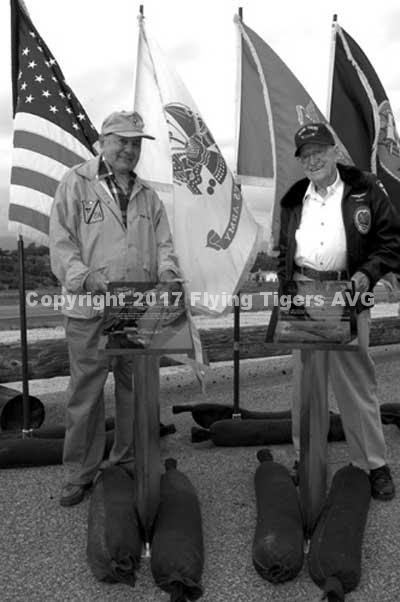
PHOTO: Fred Losch, left, and Dick Rossi, right, stand by their hall of fame plaques at the Fallbrook Air Park. The pair are the first inductees to the Fallbrook Aviation Hall of Fame.
FROM THE PACIFIC FLYER MAGAZINE:
Two famous World War II aviators were inducted into the new Fallbrook (Calif.) Aviation Hall of Fame on Veterans Day. The pair, Dick Rossi and Fred Losch, are long-time Fallbrook residents, said Tom Wilson, president of Friends of the Fallbrook Community Airport. Doug Dwyer, vice-president of FFCAP, spearheaded the hall of fame, saying it is designed to highlight the surprisingly large number of aviation exploits of Fallbrook residents. Fallbrook is a tiny airport located in North San Diego County, adjacent to Camp Pendleton.
Rossi is a 6.5 victory ace with the famed American Volunteer Group, better known as the Flying Tigers. In 1941 and ’42, the AVG surmounted huge odds during their brief but illustrious combat tour in China. When that group disbanded, Rossi remained in China, flying “The Hump” for the Chinese National Aviation Corporation. After the war, Rossi was a founding member of the Flying Tigers cargo airline.
Losch, as a Marine Corps lieutenant, served in fighter squadron VMF-214, the storied “Black Sheep” squadron headed by the colorful Gregory “Pappy” Boyington. Losch’s record includes many hair-raising ground attack missions and at least one aerial victory. After the war, Losch built a successful construction supply business in Los Angeles before retiring to Fallbrook.
Both men have strongly supported FFCAP, Wilson said. Rossi and Losch were inducted by the FFCAPark during a simple ceremony at the Air Park’s viewing common. Highlight of the ceremony was a fly-by of a P-40 Warhawk and an F4U Corsair, as flown by Rossi and Losch during World War II. Both airplanes were supplied by the Planes of Fame museum in Chino, Calif. The P-40 was flown by John Hinton; the F4U by John Maloney. Because both airplanes are fitted with jump seats and FFCAP members Mike Smith and Bonnie Wills were along for the ride.
For more information on the group, contact Wilson at (760) 728-9062.
Oct 18-21, 2012 – AVG Reunion, Columbus, GA
Four of the surviving AVG members attended. The Tigers were honored at a Basic Training Graduation at Parade Field at Fort Benning GA. They were given an extensive tour of the National Infantry Museum, presented with Quilts of Valor and had an enjoyable public Meet-and-Greet.
OUR FABULOUS TRIP TO CHINA
August 30, 2005 to September 16, 2005
by Lydia Rossi
Chapter One
What has happened in the last ten years in China? Who could have predicted that the name “Flying Tigers” would be more famous in China than it has ever been in the United States? When we first traveled to China in 1995, hardly anyone knew the name or what it referred to. As we made more trips to China in the last ten years, the level of awareness was growing, until it now is recognized even at the highest levels of the PRC, as the heroes who came to China during its time of great need and helped saved the Chinese people from the aggression of the Japanese. When I say highest levels – let me give you the best example: at a state dinner for 2,000 at the Great Hall of the People – just off of Tianamen Square, AVG pilot Dick Rossi was seated at the head table with the president of China, Hu Jintao. President Hu walked around to Dick, toasted him and thanked him for what the Flying Tigers, Hump Pilots and other American veterans did for China in WWII. The reception given to our band of American veterans and families on this trip was unprecedented and certainly unexpected. Everywhere we went in China we were treated as though we were visiting royalty – great heroes !
It continued in all of the cities we visited. We were given lavish banquets by the top government people in the area. They have different names for the positions – but think in terms of governors, mayors, heads of important ministries. For the last few years the Chinese have been producing on TV, documentaries about Chennault, AVG, 14th Air Force, Hump Pilots, and other allies who came to help fight the Japanese. There have also been several books written about it, one of which was written by our friend and trip arranger, Jeffrey Greene. For forty years Mao Zedong told his people that no foreigners had ever helped China, that the Chinese must do everything for themselves. He made sure the school books only taught his version of history. But with the gradual opening up of the society, and with the efforts of some individuals, the history is getting more accurate, with a result of gratitude from the Chinese people. There is a tendency among Chinese to give all the WWII American veterans the title of “Flying Tiger,” so our group of forty veterans were very popular everywhere we went, with throngs of reporters and autograph seekers. What fun!!
BEIJING
Our group had been invited over to help China in the celebrations which were to mark the official end of WWII or as they call it, “The Chinese War of Resistance to the Japanese Aggression” and our group was part of ceremonies all over the country. Five days in Beijing had us going to the Great Hall of the People on three occasions. Our first trip to the Great Hall was to view a magnificent musical about the war. It had a cast of maybe 500 and was a first-rate production with English interpretations on large video screens.
According to this play, it was the Chinese guerrillas and Chinese people who defeated the Japanese. Some credit was give to the Kuomintang soldiers, but no others. We found that a rather interesting interpretation of history, as I¹m sure you all do too. The second day we had a half-day of listening to speeches by old soldiers and the leaders of the country. Listening through translations headsets, we followed the speeches hoping to hear something about the help the allies had provided in the effort. Finally, in the last speech, which was by President Hu himself, he mentioned the allies and Flying Tigers help. Our third trip was to the state dinner I mentioned previously which was a big thrill to have the US veterans so highly recognized.
We were sponsored in large measure by the “Chinese People¹s Association for Friendship with Foreign Countries” which is a important ministry within the political makeup of the PRC. In every city we traveled to we had dozens of support people to help us. Many were university students who were studying English. They were at our sides to assist us at every turn – and if you picture a bunch of WWII veterans and the age they must be now – you know we needed a lot of assistance. Plus we had two excellent young ladies from “Friendship” who stayed with us throughout our travels and were able to help and advise whenever the need arose. Everyone in China now has a cell phone and they stay in constant communication with everything and everyone. I¹m sure that Beijing was kept informed of everything we did in every city.
On our first night in Beijing, we were invited to a large hall of an even larger hotel, for a dinner to honor many WWII veterans that had been invited to help in the planned ceremonies. The number at this dinner was about 1200, and included veterans from many countries, very noticeably, the Russians. Let me see – didn¹t the Russians declare war on the Japanese just after the first atomic bomb landed on Japan? Well, they jumped in before the surrender so I guess that¹s what counts. Anyway, it was a lovely dinner and an impressive award presentation. All the veterans were given a beautiful and important looking badge, which they all wore proudly throughout the rest of the trip. One of the best parts of that evening was meeting, for the first time, one of Claire Chennault¹s daughters, Rosemary. Rosemary looks to be in her 80s and was traveling with a group of her family and friends at the invitation of the ex-ambassador from China. There were children and grandchildren, and the curator of a new museum that Rosemary is starting in Louisiana for her father. We were to see them again at other functions in Beijing and in Kunming, and were delighted by their interest in everything having to do with the AVG – they all said they want to come to the AVG reunions and we told them we want to help with the museum.
Our total group with families consisted of 95 people, so we filled three buses wherever we went. Now get this – in front of the buses we had a motorcycle policeman, then a police car, both with lights flashing and sirens blaring, then the three buses, then an ambulance (they were taking no chances that any of these old guys were going to drop dead on them while in China). And they stopped traffic for us – sure made for slick traveling!!
Those doctors and nurses, who were very conscientious, came in handy a few times as our group succumbed to various mishaps. The day Dick was going to sit with the president in Beijing they came to our hotel room to give him a check up which included an EKG – I guess it would be embarrassing to have the president¹s guest go face down into the Peking Duck. Remember President Bush Sr. at a banquet in China?
Beijing will be hosting the Summer Olympics in 2008, and there are signs of improvements everywhere you go in the city. Huge new skyscrapers, freeways, broad avenues planted with trees, flowers and grass. And beautiful new parks – we were taken to a new one on the outskirts of the city for the dedication of a new Peace Wall. There were probably 1,000 people at the ceremony and our group of veterans will each have a signature on the Peace Wall, as well as the veterans from China and the other countries represented. We also went to a ceremony for the release of a new book on American Veterans in China in WWII. Jeff Greene is the man who put it all together, including writing it all, even though it had been translated into Chinese. Jeff promises an English version soon.
We took the mandatory tour to the Great Wall, and also the very impressive National Air Museum (the one in a mile-long tunnel), and the Forbidden City.
A few managed to squeeze in shopping – as we always do!
Chapter Two
ZHIJIANG
What a reception!!
I have to explain about this city. Dick and I traveled there in 2003 with Jeff and Donna Greene, Bob, Marian, and Lynda Layher, Peter and Simone Wright. We had been invited out into this “hinterland” part of China to attend the first ever “Peace and Cultural Festival” and also because it had been a headquarters for Chennault with the 14th Air Force. It did not have an airport, so we took an overnight train from Chungsha. When we arrived at the hotel, we walked through a block long of country folk dressed in “Minority” costumes on either side of us, who were singing welcome and playing unusual instruments. We were very honored – and surprised. The people of Zhijiang had not seen many foreigners and they were hugely curious about us – following us wherever we went just to look at us (I mean hundreds of them).
The Peace and Cultural Festival had a cast of 2,000 and an audience of 125,000 – it was big – the stage was about half an acre. They had 20 or more big name singers and the dancing, costumes, and staging were the best. They took us to an old brick building near where Chennault had an airfield – they were in the process of building a new airport at this site. They had turned the old headquarters building into a museum to the Flying Tigers. Anna Chennault had been there sometime ahead of us and she had donated some photographs which they had blown up and put on the walls of four or five small rooms within the building. Dick happened to be wearing a replica AVG “bomber” jacket. It was very decked out with a blood chit on the back, an AVG insignia, 1st squadron insignia, CBI patch, his name on a leather patch – very cool. Well, the director of the museum asked Dick if he would donate the jacket to his museum. That sort’a took us by surprise, but we talked it over and decided it would be the best thing to do. So within three hours they had a big ceremony in place – had a stage with a big red banner announcing the ceremony for the dedication of the jacket, singing school children, reporters, and Dick handed over his jacket.
So here we are, two years later, headed to that city again. This time we fly in on a chartered jet. They have the airport finished, but no scheduled flight as yet, in fact we were the first commercial traffic they had! Once again they had us greeted by singing school children, musicians, dancers, banner, bouquets of flowers, but this time there were about three times as many. It was a very lavish display of welcome that just swept us away. Our main hosts were the Secretary General of the Provence (who had escorted us everywhere two years ago) and also the Governor, Mayor, and many other important political persons. Once again the Peace and Cultural Festival was fabulous and they brought up onto the stage an old photograph of a group of AVG members around a P-40 which had been blown up to about 15 feet by 10 feet. The MC then told the audience about the Flying Tigers.
We went sightseeing in Zhijiang and had many wonderful banquets for lunch and dinner – I mean a lunch would be 12 or 15 dishes and the buffet dinner at the hotel had around 80 different selections. But what I want to spend words on is telling you about the Flying Tigers Memorial. I was expecting the same old museum to be spruced up, maybe a paint job, a few more items displayed, and Dick¹s jacket under glass somewhere. I was unprepared for what awaited us. As we walked towards the old building from the buses (again with the streets lined with greeters), I began to see behind the old building was a newer, bigger building. It was beautiful, made of steel and marble with sweeping stairs leading to a deck with columns holding up the soaring roof. The facade on the front announced that this was the “Flying Tigers Memorial.” We were there for the official opening and It turned out to be the most wonderful museum I have ever seen that is dedicated only to the Flying Tigers. In fact, I think it is the only museum dedicated to the Flying Tigers in the world! I will try to describe it but words will no doubt fail me.
After much ceremony for the opening of the museum, we were invited into an inner courtyard which had rooms around three sides. At the back was a wall of black marble, etched with the names of all Flying Tigers (AVG, 75th FS, 14th AF) who had died in China. In the rooms they had created magnificent displays of the Flying Tigers. And they had very little to work with – just photos of our group from two years past, and some items I had sent to them after our visit. On the walls of the rooms were floor to ceiling murals which had been taken from the photos; and Dick¹s jacket was in a three-sided glass case, hanging from the ceiling with spot lights on it. Under glass in a case, they had placed the T-shirt, the hat, the 2001 program from Seattle, pins, and photographs we had given them. From the Seattle program, they had taken all of the Squadron and Administration mug shots and blown them up to about 8 x 10 and attached them to the wall, floor to ceiling, and all back-lit. Pictures by John Shaw and Roy Grinnell were blown up large, printed on a plastic (lexan), and back-lit. Large photos of Chennault were back-lit. There was a diorama of a village of Zhijian being attacked by bombers of the Japanese. There was half a model of a P-40 (about 10 foot wingspan) sticking out from the wall with engine noises, propeller turning, and smoke puffing out. There were lots of photos on display all over of the 14th and AVG. We were bowled over – I was weeping as I walked around – it was very impressive.
We were there for about two hours, much of it taken up by the ceremonies and meeting with many Chinese soldiers from WWII who were there to greet us.
There were darling young girls dressed up in white tutus who sang and danced for us. They pulled us up into a big circle of singing and dancing all having to do with friendship and peace. I am unable with these words to give justice to how wonderful it was.
One afternoon the officials of Hunnan Province held a ceremony for the veterans in our group wherein they were awarded another beautiful and impressive looking medal. This one has a P-40 on the front of it. Zhijiang gave us the best they have to offer and it was stunning.
Chapter Three
KUNMING
Kunming was the headquarter city of the AVG Flying Tigers and General Chennault in 1941/42. When the American Volunteer Group pilots and ground crews first arrived in Kunming in 1941, the Japanese had been using the city as a training ground for their bombers, sending them over regularly and bombing indiscriminately. In December of 1941, Chennault¹s early warning network informed him of 10 bombers that were on their way to Kunming.
Sending up the P-40s to get above them, the Flying Tigers had enormous success, destroying most of the bombers, and not allowing any of them to get over Kunming with their bombs. The next day the city officials and the people of Kunming came out to the airfield with gifts of fruit, flowers and scarves to thank them. And as long as the Flying Tigers were there, the Japanese never came back to Kunming.
The people of Kunming have not forgotten this, in fact we met many relatives of people who witnessed these events. The greeting given us in Kunming was very warm and lavish with greeters, flower bouquets, music and reporters. They kept us on a whirlwind of ceremonies, banquets, special shows, interviews, and special awards so that even the young people in our group had to work to keep up.
The first day we were taken to a huge new convention center area that is blocks long, for a ceremony and photo display of what they named “The Memory of History.” This is a traveling display which was brought to the United States by Jeff Greene and Mei Ying Dung, a few years ago which shows in photography the history of WWII as it happened on Chinese soil. Don Bishop, from the American Embassy in Beijing, traveled with our group and gave many of the speeches (we always liked them, especially since they were in English).
In 1942 one of the AVG pilots was killed when his P-40 crashed into Lake Dianchi which is on edge of the city of Kunming. When the Chinese authorities learned (about ten years ago) that the plane was left in the water, they set out to locate it, which they think they have – buried in about fifteen feet of silt. With the establishment of Jeff Greene¹s foundation (Sino-American Heritage Foundation) in cooperation with the Chinese, there has been an operation to try and dredge enough around the P-40 to be able to raise it up. This has been an ongoing project for about five years now and the last couple of times we have traveled to Kunming they have taken us out in boats to the site of the dredging operation. This was no exception and we were treated to a pleasant boat ride and then we dropped flowers at the site and motored back. They showed us parts of an airplane they have retrieved from the lake, but no one seems to know what type of aircraft it belongs to. We have hopes of one day watching them pull a P-40 out of that lake.
There is another smaller lake in Kunming, Green Lake. We had stayed at the Green Lake Hotel about ten years ago, so when I saw on the itinerary that we were going there again, I was looking forward to seeing the old hotel. Well, it has been rebuilt into a big, beautiful five-star luxury hotel. Here we were given a lavish banquet by the Mayor of Kunming, Wang Wen Tao, and each of the veterans was presented with a book/certificate which proclaimed them to be “Honorary Citizens of Kunming.” We are told that it is more than just words, that if you return to Kunming you can claim certain rights and privileges. We will have to let you know if that is true when we return to Kunming next time – I know we sure had lots of privileges on this trip.
Yunnan coffee, I¹m told, is the best in China and they have a brand they have named “Hump Coffee” which they gave us. In fact we were given so many wonderful, large and heavy gifts on this whole trip that I don¹t know of anyone who didn¹t have to buy another piece of luggage somewhere along the way. When the Mayor of Kunming asked me what was my best impression of Kunming, I told him that my biggest surprise was to find that my husband seemed to be a celebrity here. We all had a laugh and he assured me that Dick is a “great hero.” Dick informed me that he probably wouldn¹t be able to take out the garbage anymore because his status had risen too high!
One afternoon we were taken to Yunnan University in Kunming. In an auditorium, they held a symposium for the Flying Tigers with the students asking questions in English. Some of the students told us how their grandparents had told them the story of living through WWII and the Japanese bombing of their city, and then the Flying Tigers came and fought them off and they never came back to bomb the city again. The heart warming thanks that these students expressed to our veterans was another heart warming, tearful moment. Dick Rossi was asked, as he has been asked before, why did he volunteer to leave the Navy, travel to China and fight the Japanese? Dick has put his response into writing, which I would like to insert here:
“In 1941 I was twenty-six years old. I had been in the U.S. Navy for two years, one year learning to fly and the second year as a flight instructor.
I was anxious to do more and it is the dream of every young military pilot to fly fighter aircraft. When the recruiters came to my base in Pensacola, Florida, looking for volunteers for a secret mission to go to China and help defend it from the Japanese, I was one of the first to sign up. It sounded like a great adventure – a chance to fly a powerful fighter plane, to travel the world, and to do my part to defeat an aggressive enemy. Today I am ninety years old and I have seen many changes in the world. It is a source of great happiness to me to see that the efforts of a young man, our group of Flying Tigers, and all the Americans who fought in China, are now being seen as a reason – a bridge – for friendship between our two great nations. I feel proud to have been part of the effort in the war – and I feel humbled and thankful for the outpouring of respect and love from the Chinese people.”
On our last night in Kunming we were given another lavish banquet hosted by the head of the Communist Party in Yunnan. After the banquet we were put on the buses again to attend an opera. This was not the typical Chinese opera.
This was a special Cantata which was written, conducted, and performed in an arts college in Kunming. The opera told the story of the Flying Tigers in Kunming! It was a small theatre, seating perhaps 300 and the story of the Flying Tigers was all sung, mostly by a large choir of 100 singers, with a conductor, pianist, and several vocalists with English titles on a screen on the side of the stage. The first part of the opera dealt with what a pleasant life the simple people of Kunming had prior to the Japanese bombing. It told the story of the farmers, the families, and how simple and easy their life was. When they heard the Japanese were going to bomb them, they didn¹t know what a bomb was and thought perhaps it was like an egg.
“Should we put up an umbrella? or crawl under the table?” They soon found out what a bomb was and what it could do. They sang of the misery, the horrible destruction, and the inability to stop it. Then – along came the Flying Tigers!! Four male singers came on stage wearing pilot uniforms and they sang about coming to Kunming and the fighting against the enemy. Then out came the best singer of the evening – General Chennault! Well, it was crying time again as we all brought out tissues. What a great honor – we could hardly believe it! I found out that this opera had been been performed all around the province and on television several times. Words fail me to describe how moved and humbled we all felt.
Chapter Four
NANJING, Jiangxi PROVINCE
If you were ever in Nanjing before – you would never know it today. It used to be a rather backward, poor looking city when compared to Beijing and Shanghai. Now it rivals them for modern development and beauty. One of the places they took us was to a complete community development, so new that no one was living there yet. It had wide streets, shopping malls, condominiums, schools and a gymnasium that was going to host an Olympic Event. We were taken into a very large room with a diorama of the whole complex layout. We laughed over who in our group was going to by the first to buy a time-share.
Nanjing is the place where they have a huge, beautiful monument dedicated to foreign aviators who died in China in WWII. We had visited it in 1995 and we went again. There was a ceremony with wreath laying and lots of media attention. The monument has beautiful black marble walls with the aviators names etched in – very similar to our Viet Nam Memorial in DC.
We were able to meet up with an old friend who had come from Shanghai to be with us, General Han Di Cai and his wife. They had hosted us in Shanghai in 1995 and 1997. An interesting history is the story between Gen Han and American Fighter Ace, Hal Fischer. During the Korean War, Hal was shot down by Han, captured, and spent about two years as a POW in China. Hal had been with us on a tour in 1997 and had a much publicized reunion with Gen Han.
Roy Grinnell has created a painting of the incident of Hal¹s shoot-down.
Gen Han was in charge of all the air defenses of Shanghai, but I think he is now retired. Hal was on this trip also, and they were enjoying the renewed friendship.
During all the restoration and build up of Nanjing, they unearthed a mass grave that dates to the infamous “Rape of Nanking” (1937) which they have now turned into a memorial to those who were massacred by the Japanese (300,000). It has beautiful park-like grounds with memorials in many places to those who died there. There is a life-size bronze statue of Iris Chang, who wrote the book which helped to publicize the atrocity to the whole world. There is a roof that covers a site where they have left the many remains of bodies that have been partially excavated. Very sad and sobering.
As I was walking around, a Chinese lady started talking to me in very good English, explaining my surroundings and asking questions. She asked me if Americans know about the “Rape” and I said yes they do, especially because of Iris Chang¹s book, although people who study history knew about it, as it is well documented. She asked me if I knew that the Japanese still don¹t admit to any part in it and I told her yes, that is also well known.
Then she asked me what I thought of this denial by the Japanese … did I think it made them more diplomatic to deny it? I said no, I thought it made them liars. Later at a banquet, I saw that she was an interpreter/aide to the Mayor of Nanjing. (!)
SHANGHAI, JIANGSU PROVINCE
We were treated to the last of our wonderful banquets, held in one of the big rooms of our five-star hotel. It was hosted by The Chinese People¹s Association of Friendship with Foreign Countries, Shanghai International Culture Association, and Jeff Greene¹s Sino-American Aviation Heritage Foundation.
We had the honor of having two members of the Doolittle Raiders in our entourage, Richard Cole (Doolittle¹s co-pilot) and Tom Griffin. At this last banquet, they had Chinese people who had assisted the Raiders escape the Japanese and get them back to the allies. The Japanese had extracted a terrible price from the villagers who helped the Americans. I understand there is very good documentation and studies that put the number they executed at around 200,000. It was a touching tribute between the two Raiders and the Chinese.
We had another fun evening with our friends General and Mrs. Han Di Cai.
The General has written his life story in a book which he presented to us – in Chinese of course.
I must give a tribute to Jeff Greene for the most fantastic trip I have ever been on. He worked for months arranging the whole trip with the Chinese. He did a spectacular job – our heart-felt thanks go out to Jeff.
Sept 1-5, 2011 – AVG Reunion, Cleveland, OH
The Tigers were honored at the Cleveland National Air Show. A delegation from the Thunderbirds, the Air Force aerial demonstration team, greeted the 4 Tigers in attendance. We enjoyed a Chinese dinner at the Bo Loong restaurant and services at Old Stone Church.
The AVG was honored to have Gen. Donald Hoffman, commander of the Air Force Materials Command as its guest speaker at the Banquet. Entertainment was provided by the Cleveland Firefighters Bagpipe Band and the USAF Band of Flight from Wright Patterson Air Force Base.
June 2-6, 2010 – AVG Reunion, Las Vegas, NV
Four of the surviving AVG members attended. General Chennault’s daughter, Rosemary Simrall, and his granddaughter, Nell Calloway, also attended. The Tigers were met by Gen. Handy and honored with an extensive tour and maintenance brief at the Air Warfare School at Nellis AFB. There was indeed lots of “iron on the ramp at Nellis!” We were surprised to meet Joe Chennault, a relative of the general….and he’s an Air Force pilot in the Aggressor Squadron….yes, it’s fighter tactics at its very best! The AVG Banquet was held atop the Stratosphere Tower with spectacular sunset views of Las Vegas and The Strip. The President of Mercury Air, Mr. Joe Czyzyk, honored the Tigers.
July 1-5, 2009 – AVG Reunion, Boston, MA
Five of the surviving AVG attended. The Tigers were honored aboard USS Constitution “Old Ironsides” and at a sumptuous Chinese dinner at the Empire Garden restaurant in Chinatown by Republic of China war veterans, TECO and the Boston Chinese community. The Grand Finale was an eagle’s eye view of the spectacular 4th of July fireworks over the Charles River in Boston.
May 7-11, 2008 – AVG Reunion, San Antonio, TX
Eight of the 19 surviving AVG members attended. The Tigers were honored at Lackland AFB and at a memorial service at the Admiral Nimitz Museum of the Pacific War in Fredericksburg, Texas.
April 26-29, 2007 – AVG Reunion, Charleston, SC
The Tigers were honored guests for a tour of Charleston AFB.
April 5, 2007 – Opening Day for the Lakeland (FL) Flying Tigers baseball team.
Chuck Baisden and Frank Losonsky were honored guests.
June 9-12, 2005 – AVG reunion in Grand Rapids, MI
Twenty of the surviving 33 AVG members were present, along with family and friends. In addition to a symposium at the Gerald Ford Presidential Library and a public autograph session, the Tigers were interviewed by local and area media.
- TOSHIBA Exif JPEG
- AVG Panel, Ford Museum in Grand Rapids, AVG Forum
- Meijer Gardens
- Meijer Gardens
- Michigan Military Institute AVG Signing in Grand Rapids
- Joe Poshefk0 & Joe Rosbert
- Dick & Lydia Rossi
- Ford Museum in Grand Rapids, AVG Forum
- Ford Museum in Grand Rapids, AVG Forum
